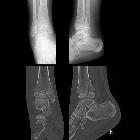triplane fracture









Triplane or triplanar fractures are of the distal tibia only occurring in adolescents. As the physiological closure of the physeal plate begins medially, the lateral (open) physis is prone to this type of fracture. The name is due to the fact of the fracture expanding both in frontal and lateral as well as transverse planes. Most authors regard it as a type IV Salter-Harris fracture.
It comprises of:
- a vertical fracture through the epiphysis
- a horizontal fracture through the physis
- an oblique fracture through the metaphysis
As physeal closure has to begin at an end, triplane fractures have occasionally been reported in other sites too, e.g. distal radius , proximal tibia , distal femur .
Epidemiology
In adolescents with closing epiphyseal plate(s) they are the most common ankle joint fractures - along with Tillaux fractures.
Clinical presentation
Symptoms comprise of pain and inability to weight bear. Possible signs include swelling, localized/referred pain, and/or deformity of the ankle.
Pathology
Mechanism
External rotation and supination is the main mechanism of injury in lateral triplane fractures. The uncommon medial variation usually occurs with an adduction force .
Radiographic features
Plain radiograph
Standard ankle series suggested; AP, lateral and Mortise (best view to define displacement). Due to the aforementioned characteristics, the fracture typically resembles;
- Salter-Harris III fracture on AP
- Salter-Harris II fracture on lateral
Small dislocations and the vertical fracture itself are frequently overlooked, and CT is advised if there is concern.
CT
The imaging modality of choice, permitting identification of;
- fracture pattern and articular congruity
- fragment number and orientation/relationship
For the same reasons, CT aids in treatment planning as well .
MRI
May be used to reveal associated ligamenteous injuries, osteochondral fractures and chondral fractures .
Treatment and prognosis
Treatment options comprise of surgery (i.e. open reduction and internal fixation - ORIF) and conservative management (i.e. long leg cast immobilization). Physeal arrest may occur in 7% to 21% of cases, which may rarely lead to angular deformity. The significance of preserving the physis is questionable given the limited remaining growth potential, but patients with greater than 2 years of growth remaining should be followed.
History and etymology
The term was coined by L Marmor in 1970 .
Differential diagnosis
On radiographs, possible considerations include;
Siehe auch:
und weiter:

 Assoziationen und Differentialdiagnosen zu Triplane-Fraktur:
Assoziationen und Differentialdiagnosen zu Triplane-Fraktur:
